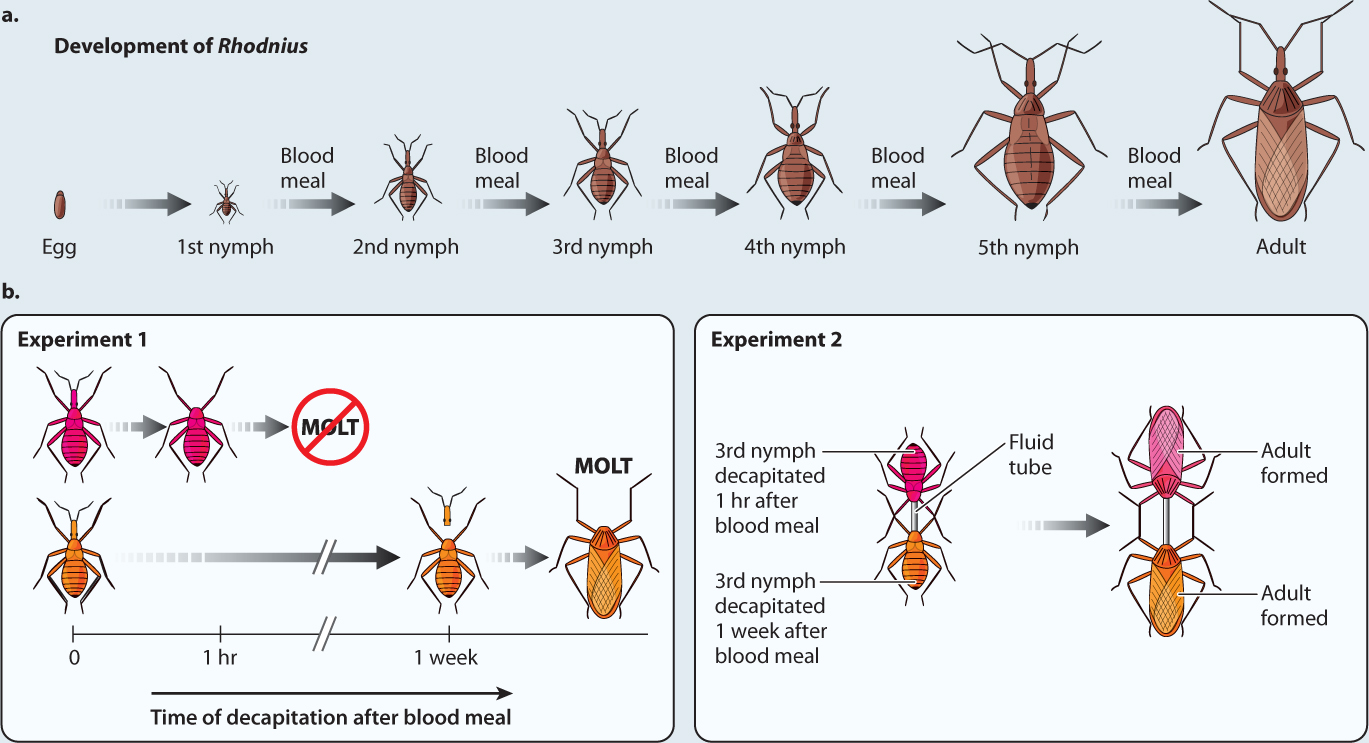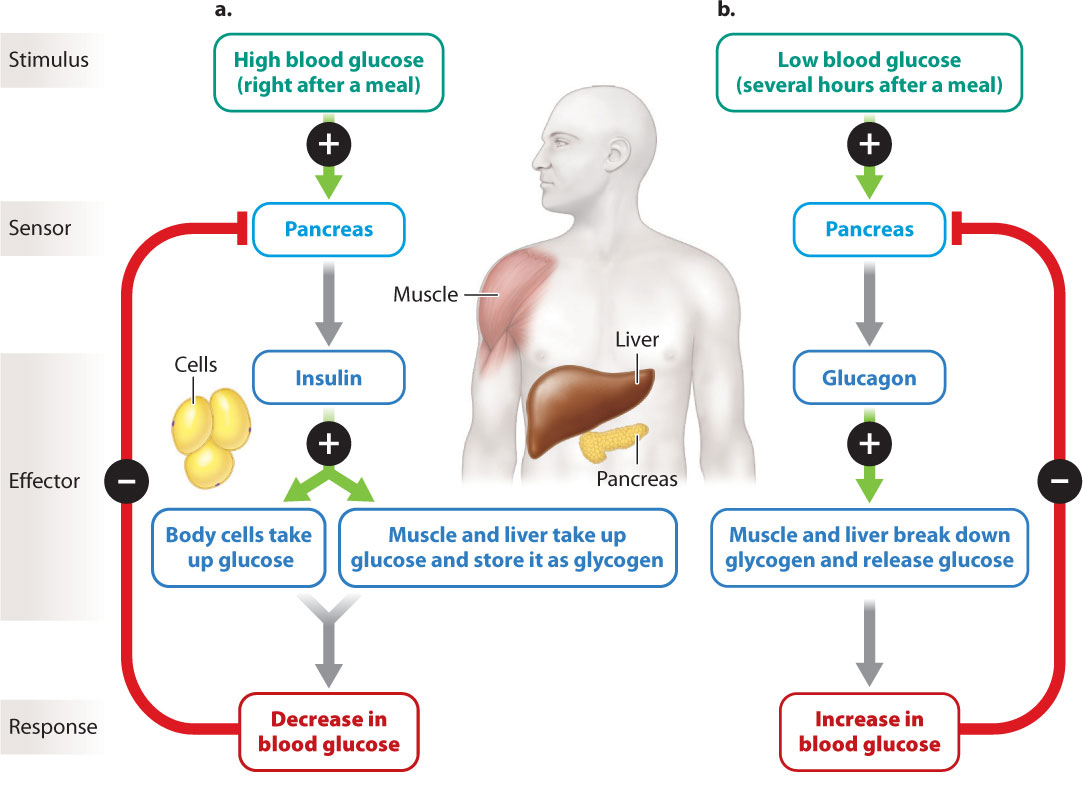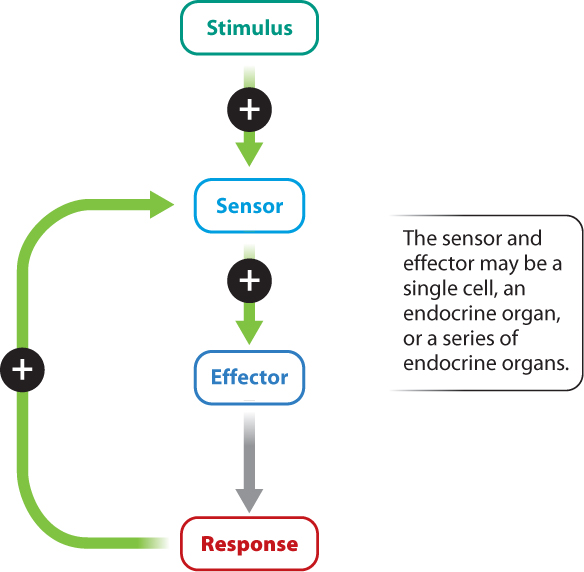38.1 AN OVERVIEW OF ENDOCRINE FUNCTION
The word “hormone” often popularly connotes teenagers and the changes that occur to their bodies as they grow and mature. Hormones, as we will see, do have key functions in animal growth and development—but that is only one of their roles. Hormones play diverse physiological roles in the body, including regulating an organism’s response to the environment and helping to maintain stable physiological conditions within cells or within the animal as a whole. We start by highlighting these functions before addressing the molecular mechanism of how hormones work.
38.1.1 The endocrine system helps to regulate an organism’s response to its environment.
Organisms face constant changes in their environment. These changes often present physiological challenges or stresses that the organism must respond to by altering the functional state of its body. Changes in light or temperature, the threat of a predator, or the presence of a potential mate stimulate responses of an animal’s nervous system and endocrine system. Endocrine responses are commonly triggered by sensory signals received by the nervous system that are relayed to the endocrine system. The endocrine system, with its slower and more prolonged signaling, reinforces physiological changes in the animal’s body that better suit the environmental cues received by its nervous system.
When a gazelle sees or smells a predator, its endocrine system helps to ready its body for rapid escape. When a female cardinal sees a bright red, singing male early in spring, endocrine signals transmitted within the female cardinal’s brain initiate changes in its reproductive organs and increase its behavioral responsiveness, encouraging it to select the male as its mate. And when particular smells stimulate a sense of hunger and digestive function in animals, such as dogs and humans, the animals are attracted to food. In each of these cases, the endocrine system helps an organism respond appropriately to environmental cues.
38.1.2 The endocrine system is involved in growth and development.
The endocrine system plays important roles in growth and development, which require broad changes in many different organ systems. The release of circulating hormones accomplishes these changes, regulating how animals develop and grow. For example, we discuss in Chapter 42 the importance of the sex hormones estrogen and testosterone in determining female or male sexual characteristics during embryonic development and in sexual development during puberty.

As another example, consider the well-studied endocrine system of insects, which regulates their growth and development. Insects produce a rigid exoskeleton (Chapter 37), which must be periodically shed and a larger new one made to enable the insect to grow (Fig. 38.1). Shedding of the exoskeleton is referred to as molting. Each molting produces a new larval stage. In some insects, such as moths, the animal’s body also changes dramatically, undergoing metamorphosis at key stages in development (Fig. 38.1a). In other insects, such as grasshoppers and crickets, the animal grows larger after each molting, but with little change in body form (Fig. 38.1b).
Molting and metamorphosis are regulated by hormones released from tissues in the insect’s head. British physiologist Sir Vincent Wigglesworth studied their effects on the growth and development of the blood-sucking insect Rhodnius. Normally, Rhodnius goes through five juvenile stages before developing into its final adult body form. Like grasshoppers and crickets, it does not undergo metamorphosis. Each of the developmental stages is triggered by a blood meal. Wigglesworth showed that he could prevent molting if the head of the insect were removed shortly after a blood meal (Fig. 38.2). However, if the insect takes a blood meal and the head is removed a week later, the animal’s body undergoes a molt and grows into its adult form. Wigglesworth hypothesized that a diffusing substance from the animal’s head controls its molt. In the first case, this substance does not have time to reach the body to trigger a molt, but in the second it does.
FIG. 38.2How are growth and development controlled in insects?
BACKGROUND During the 1930s, British physiologist Sir Vincent Wigglesworth studied how a blood meal taken by the bug Rhodnius triggered its molting and growth. This work pioneered the discovery of hormonal substances that stimulated its growth. Rhodnius goes through five successive larval stages (called nymphs) before becoming a winged adult, as shown in Fig. 38.2a. Each developmental step is triggered by a blood meal.
HYPOTHESIS Wigglesworth hypothesized that a substance (specifically, a hormone) that diffuses from the head triggers molt in Rhodnius.
EXPERIMENT Wigglesworth decapitated juvenile bugs at different intervals of time after a blood meal and observed whether or not molting occurred. (Decapitation does not kill the insect.)
RESULTS Wigglesworth showed that if a bug is decapitated less than an hour after a blood meal, it fails to molt. If a bug is decapitated 1 week after the blood meal, it molts (Fig. 38.2b, Experiment 1). He also found that if he used a fluid tube to join the body of a bug decapitated immediately after a blood meal with the body of one that wasn’t decapitated until a week after feeding, the bodies of both bugs molted (Fig. 38.2b, Experiment 2). This experiment demonstrated that the diffusing hormone could trigger molting in the bug that lacked the hormone because of immediate decapitation.

CONCLUSION A substance diffuses from the head in Rhodnius and triggers the molting process.
FOLLOW-UP WORK Subsequent studies by the German endocrinologist Alfred Kuhn confirmed the result in experiments performed on moth caterpillars. More recent molecular analyses performed by Japanese molecular endocrinologists Nagasawa and colleagues (1984) and Kawakami and colleagues (1990) isolated and sequenced the structure of the hormone from silkworm moths. It is now known as prothoracicotropic hormone, or PTTH, because it acts on the prothoracic gland of the insect to release the molting hormone, ecdysone.
SOURCES Wigglesworth, V.B. 1934. “The Physiology of Ecdysis in Rhodnius prolixus (Hemiptera). II. Factors Controlling Moulting and ‘Metamorphosis.’”Quarterly Journal of Microscopical Sciences 77:191–223; Nagasawa, H., H. Kataoka, A. Isogai, S. Tamura, A. Suzuki, H. Ishizaki, A. Mizoguchi, Y. Fujiwara, A. Suzuki. 1984. “Amino-Terminal Amino Acid Sequence of the Silkworm Prothoracicotropic Hormone: Homology with Insulin.” Science 226:1344–1345; Kawakami, A., H. Kataoka, T. Oka, A. Mizoguchi, M. Kimura-Kawakami, T. Adachi, M. Iwami, H. Nagasawa, A. Suzuki, H. Ishizaki. 1990. “Molecular cloning of the Bombyx mori Prothoracicotropic Hormone.” Science 247:1333–1335.
The German endocrinologist Alfred Kuhn found a similar result in experiments performed on moth caterpillars. Tying the caterpillar’s head off from the rest of the body prevented the body from molting. Wigglesworth and Kuhn considered the diffusing substance to be a brain hormone. Subsequent work showed that cells in a specialized region of the insect brain secrete the peptide now known as prothoracicotropic hormone (PTTH) (Table 38.1). In Rhodnius, PTTH is released after a blood meal and acts to trigger the animal’s molt by stimulating the release of ecdysone from the prothoracic gland.
| Major Invertebrate Hormones | |||
|---|---|---|---|
| SECRETING TISSUE OR GLAND | HORMONE | TARGET GLAND OR ORGAN | ACTION |
| Brain | Brain hormone (peptide) | Prothoracic gland | Stimulates release of ecdysone to trigger molt and metamorphosis |
| Corpora allata | Juvenile hormone (peptide) | All body tissues | Inhibits metamorphosis to adult stages; stimulates retention of juvenile characteristics |
| Prothoracic gland | Ecdysone (steroid) | All body tissues | Stimulates molt and, in absence or low levels of juvenile hormone, stimulates metamorphosis |
| Nervous system | Ecdysone (steroid) | All body tissues | Stimulates growth and regeneration in sea anemones, flat worms, nematodes, annelids, snails, and sea stars |
| Brain | Melanocytestimulating hormone (peptide) | Chromatophores | Stimulates pigmentation changes in cephalopods (octopus, squid, and cuttlefish) |
| Brain and eye stalks | Chromatotropins (peptides) | Chromatophores | Stimulates pigmentation changes in crustaceans |
| Reproductive gland | Androgen (peptide) | Reproductive tract | Regulates development of testes and male secondary sexual characteristics of crustaceans |
Two decades later, the German endocrinologist Peter Karlson isolated and purified a second hormone, termed ecdysone. Whereas PTTH triggers molting, ecdysone coordinates the growth and reorganization of body tissues during a molt. Ecdysone is released from a gland when stimulated by PTTH (Table 38.1). Karlson was able to purify a small amount of ecdysone from large numbers of silk moth Bombyx caterpillars. He ultimately isolated a mere 25-mg sample from 500 kg of moth larvae! This tiny amount highlights the general principle that relatively few hormone molecules can have a large effect on an organism.
In his studies of Rhodnius, Wigglesworth also noted that, whatever the larval stage, the decapitated bug always molted into an adult after its blood meal. By removing just the front brain region of the head, Wigglesworth was able to show that a region in the head close to the brain releases a hormone that normally prevents the earlier larval stages from molting into the adult form (Table 38.1). This hormone, called juvenile hormone, is released in decreasing amounts during each successive larval molt. After the fifth and final stage, the level of juvenile hormone is so low that it no longer blocks maturation, allowing the final molt to undergo metamorphosis into the adult form (Fig. 38.3).

These studies reveal how small amounts of hormones released from key glands within the animal’s body regulate major stages of growth and changes in body form during metamorphosis. When an animal’s body requires coordinated changes in multiple organ systems, hormonal regulation by the endocrine system plays a critical role.
Hormones also regulate growth in humans and other vertebrate animals. Growth hormone controls the growth of the skeleton and many other tissues in the human body. Growth hormone is produced by the pituitary gland, which is located beneath the brain. Tumors of the pituitary that cause an overproduction of growth hormone lead to conditions of gigantism, and tumors that result in too little growth hormone cause pituitary dwarfism. The role of the pituitary gland in regulating body function will be described later in the chapter.
38.1.3 The endocrine system underlies homeostasis.
In addition to helping an animal respond to the environment and regulating growth and development, hormones synchronize and coordinate multiple bodily processes over longer time periods. Consequently, endocrine control of internal body functions is central to homeostasis, the maintenance of a steady physiological state within a cell or an organism (Chapters 5 and 35).
Physiological mechanisms that maintain a stable internal environment are necessary because without them, changing environmental conditions would lead to dangerous shifts in an animal’s physiological function. For example, an animal’s body weight depends on the regulation of its energy intake relative to energy expenditure. Disruption of hormones that regulate appetite and food intake can lead to food disorders that promote obesity or lead to weakness and lethargy. Similarly, hormones that regulate the concentration of key ions in the body, such as Na+ and K+, are fundamental to healthy nerve and muscle function (Chapters 35 and 36) and to fluid balance within the body (Chapter 41).
How does the body, and in particular the endocrine system, maintain homeostasis? Hormones are released in response to stimuli and have an effect on distant organs. Homeostatic regulation, or maintenance of homeostasis, depends on feedback from the target organ sent back to the endocrine gland that secretes the hormone. In feedback, a stimulus evokes a response, which in turn affects the stimulus. Thus, feedback is the means by which a signal produced by the regulatory organ can modify its own subsequent production, either inhibiting or stimulating it. There are two general types of feedback, negative feedback and positive feedback.

Homeostasis typically depends on negative feedback for control. In negative feedback, a change in a system causes a response that brings the system back to the starting point. If we consider the components of such a system, we can define a stimulus (the change itself), a sensor (which detects the change), an effector (which leads to a response), and the response (which ultimately opposes the initial change), thereby feeding back information to the sensor that limits a further response (Fig. 38.4). In Chapter 35, we saw how both the temperature in a house and the core body temperature of an animal are maintained at a constant level by this type of control.
In fact, many physiological parameters are maintained at steady levels by negative feedback. In the case of the endocrine system, a stimulus leads to release of a hormone, and the hormone causes a response in the body that opposes the initial stimulus so that secretion of the hormone is decreased and there is a limit to further change. For example, blood-glucose and calcium levels are kept within a narrow range by negative feedback. Although the parameter—temperature, glucose levels, calcium levels—does not change, constant feedback between the response and sensor maintains a set point. That is, the maintenance of homeostasis is an active process.
Let’s examine an example in more detail. Like core body temperature, the amount of glucose in the blood of animals is maintained at a steady level (Fig. 38.5). If glucose levels are too low, cells of the body do not have a ready source of energy. If glucose levels are too high for too long, they can damage organs.

Maintaining steady blood glucose levels is challenging because glucose is commonly absorbed into the bloodstream from the intestine after a meal, and glucose is readily taken up by cells to meet their energy needs. How then are constant levels maintained in the body? After a meal, when blood glucose rises, β (beta) cells of the pancreas secrete the hormone insulin, which circulates in the blood (Fig. 38.5a). In response to insulin, muscle and liver cells take up glucose from the blood and convert it to a storage form called glycogen (Chapter 7). In this way, insulin guards against high levels of glucose in the blood.

What happens if blood glucose levels fall too low several hours after a meal? In this case, a different population of cells in the pancreas, called α (alpha) cells, secrete the hormone glucagon, which has effects opposite to those of insulin (Fig. 38.5b). Glucagon stimulates the breakdown of glycogen into glucose and its release from muscle and liver cells. The result is that blood glucose levels rise. In both cases, the stimulus (either high or low blood glucose levels) is sensed by cells of the pancreas (β or α cells) and triggers a response (secretion of insulin or of glucagon, bringing blood glucose levels back to the set point). Note that in each case the response feeds back to the secreting cells to reduce further hormone secretion.
When the control of blood glucose levels by insulin fails, a disease called diabetes mellitus results. When untreated, diabetic individuals excrete excess glucose in their urine because blood glucose levels are too high. Diabetes also causes cardiovascular and neurological problems, including loss of sensation in the extremities, particularly the feet.
In some instances, it is necessary to enhance the production of a hormone, accelerating the response of the target cells for a period of time. Positive feedback provides this enhancement (Fig. 38.6). In positive feedback, a stimulus causes a response in the same direction as the initial stimulus, which leads to a further response, and so on. In positive feedback in the endocrine system, a stimulus leads to secretion of a hormone that causes a response, and the response causes the release of more hormone. The result is an escalation of the response. A positive feedback loop reinforces itself until it is interrupted or broken by some sort of external signal.
Positive feedback occurs in mammals during childbirth (Chapter 42). In response to uterine contractions, the hormone oxytocin is released from the pituitary gland. Uterine contractions in turn stimulate the pituitary gland to secrete even more oxytocin, causing the uterine muscles to contract more forcefully and more frequently.
Quick Check 1
Diabetes mellitus is a disease characterized by high blood glucose levels. What two different physiological conditions can produce diabetes?